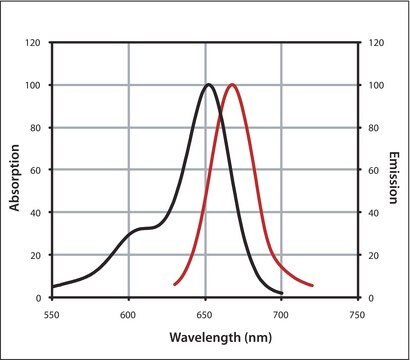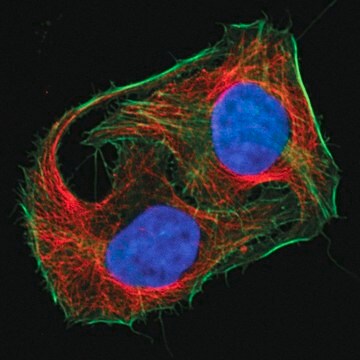343210
FITC Labeling Kit
Synonym(s):
FITC Antibody Labeling Kit, FITC Conjugation Kit, Fluorescent Labeling Kit
Sign Into View Organizational & Contract Pricing
All Photos(1)
About This Item
UNSPSC Code:
41116133
NACRES:
NA.41
Recommended Products
manufacturer/tradename
Calbiochem®
Quality Level
storage condition
OK to freeze
protect from light
storage temp.
2-8°C
General description
Provides means to quickly and simply label antibodies or other proteins with fluorescein. Direct labeling of the primary antibody eliminates the need for a secondary antibody, and results in a lower background and overall higher signal-to-noise ratio. Each kit is sufficient to perform at least five conjugations on proteins of 100 µg to 2.5 mg each.
Components
Fluorescein (five vials), Carbonate Buffer Concentrate, DMF Solvent, PBS Buffer Concentrate, and a user protocol.
Warning
Toxicity: Multiple Toxicity Values, refer to MSDS (O)
Principle
The Calbiochem FITC Labeling Kit provides a means of quickly and simply labeling antibodies or other proteins with fluorescein. FITC-antibody conjugates are useful in many applications, such as flow cytometry and immunocytochemistry. Other proteins such as steroids may also be labeled with FITC. Direct labeling of the primary antibody eliminates the need for a secondary antibody, and therefore results in a lower background and an overall higher signal to noise ratio.
Preparation Note
Antibody/Protein Preparation: Add 10 ml of carbonate buffer concentrate to 990 ml of distilled water and dialyze antibody in buffer overnight.
Analysis Note
1. Read the absorbance of the FITC-antibody conjugate at two wavelengths: 280 nm and 495 nm. Use the 1X PBS/0.1%NaN3 as the spectrophotometric blank. Optimal absorbance readings of the conjugated protein will be within the range of 0.2-1.2 ABS.
2. Using the two absorbance readings, calculate the F/P molar ratio of the FITC/Protein conjugate using the following equation:<div class="Bio_doc_image">Figure 1: F/P Molar Ration
</div>
3. There are 2 equations used for the determination of the concentration of the FITC-antibody conjugate. If the protein used for conjugation was IgG, use the following equation to estimate the concentration of the labeled antibody:<div class="Bio_doc_image"><p class="title">Figure 2: Concentration of FITC-IgG
</div>If the protein conjugated was not IgG, use the following equation to estimate the concentration of conjugated protein:<div class="Bio_doc_image">Figure 3: Concentration of FITC-Protein
</div>Where E0.1% is the A280 reading of a 1 mg/ml solution of the unconjugated protein, as measured in a cuvette of 1 cm path length.
2. Using the two absorbance readings, calculate the F/P molar ratio of the FITC/Protein conjugate using the following equation:<div class="Bio_doc_image">Figure 1: F/P Molar Ration
</div>
3. There are 2 equations used for the determination of the concentration of the FITC-antibody conjugate. If the protein used for conjugation was IgG, use the following equation to estimate the concentration of the labeled antibody:<div class="Bio_doc_image"><p class="title">Figure 2: Concentration of FITC-IgG
</div>If the protein conjugated was not IgG, use the following equation to estimate the concentration of conjugated protein:<div class="Bio_doc_image">Figure 3: Concentration of FITC-Protein
</div>Where E0.1% is the A280 reading of a 1 mg/ml solution of the unconjugated protein, as measured in a cuvette of 1 cm path length.
Other Notes
Due to the nature of the Hazardous Materials in this shipment, additional shipping charges may be applied to your order. Certain sizes may be exempt from the additional hazardous materials shipping charges. Please contact your local sales office for more information regarding these charges.
Legal Information
CALBIOCHEM is a registered trademark of Merck KGaA, Darmstadt, Germany
signalword
Danger
hcodes
Hazard Classifications
Eye Irrit. 2 - Repr. 1B - Resp. Sens. 1 - Skin Sens. 1
Storage Class
6.1C - Combustible acute toxic Cat.3 / toxic compounds or compounds which causing chronic effects
Certificates of Analysis (COA)
Search for Certificates of Analysis (COA) by entering the products Lot/Batch Number. Lot and Batch Numbers can be found on a product’s label following the words ‘Lot’ or ‘Batch’.
Already Own This Product?
Find documentation for the products that you have recently purchased in the Document Library.
Johanna W Hellinger et al.
Frontiers in oncology, 9, 1074-1074 (2019-11-12)
Background and Objective: Matricellular proteins modulate the micro environment of tumors and are recognized to contribute to tumor cell invasion and dissemination. The cysteine-rich angiogenic inducer 61 (CYR61) is upregulated in mesenchymal transformed and invasive breast cancer cells. CYR61 correlates
Our team of scientists has experience in all areas of research including Life Science, Material Science, Chemical Synthesis, Chromatography, Analytical and many others.
Contact Technical Service







